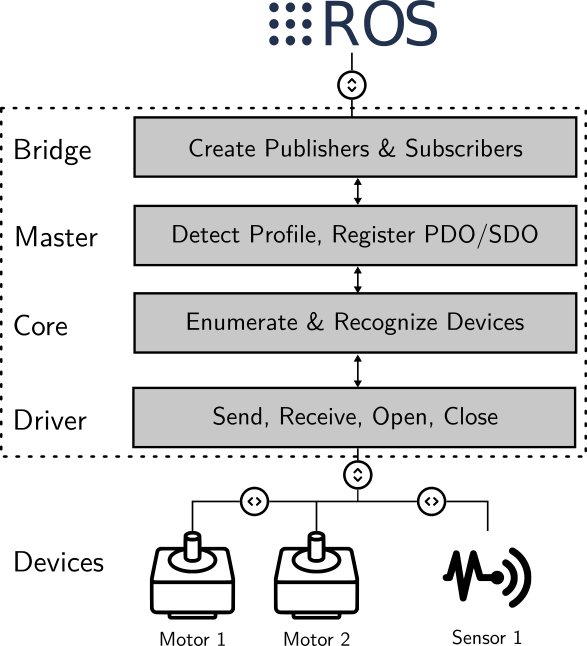Contents
Documentation
For now please, please refer to https://github.com/KITmedical/kacanopen/blob/master/README.md.

Excerpt from documentation on github:
KaCanOpen is an easy-to-use CANopen stack, which consists of four parts:
Drivers: A wide range of hardware is supported using different CAN drivers. They have been developed by the CanFestival project. Read this for details.
Core: This is a library which implements basic CANopen protocols like NMT, SDO and PDO. As an example, you can easily fetch a value from a device (uploading in CanOpen terminology) via core.sdo.upload(node_id, index, subindex). It furthermore allows you to register callbacks on certain events or any incoming messages, so one can build arbitrary CANopen nodes (master or slave) using this library.
Master: This library is intended to be used for a master node. It detects all nodes in a network and allows to access them via standardized CiA® profiles. For example, on a motor device (profile CiA® 402) you can simply call mymotor.set_entry("Target velocity", 500). A main feature of this library is transparent SDO/PDO access to dictionary entries: By default a value is fetched and set via SDO. But you can configure PDO mappings to instead keep the value up-to-date in background via (more lightweight) PDO messages. The call itself (mymotor.set_entry("Target velocity", 500)) keeps unchanged.
ROS Bridge: This library provides a bridge to a ROS network, which makes KaCanOpen especially interesting for robotics. After setting up the CANopen network, the library can publish slave nodes so they are accessible through ROS messages. Special effort is put into the use of standardized message types which allows interaction with other software from the ROS universe. For example, motors can be operated using JointState messages.
KaCanOpen is designed to make use of modern C++11/14 features and to avoid redundant code on the user side wherever possible. Reusing all the available functionality in Core, Master and Bridge, a custom node for a custom CANopen device can be written in less than 100 lines of code.
Related publication
@inproceedings{kacanopen2016,
title = {KaCanOpen: An Open Plug&Play CANopen Stack for ROS in Modern C++},
author = {Thomas Keh, Andreas Bihlmaier, Julien Mintenbeck and Heinz W{\"o}rn},
booktitle = {Proceedings of the 47th International Symposium on Robotics (ISR)},
year = 2016
}